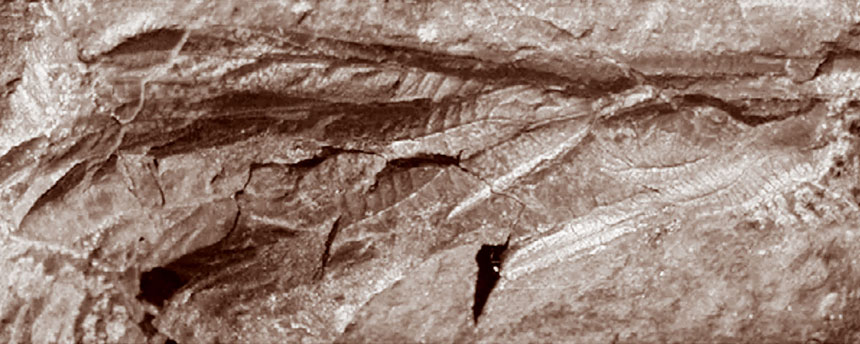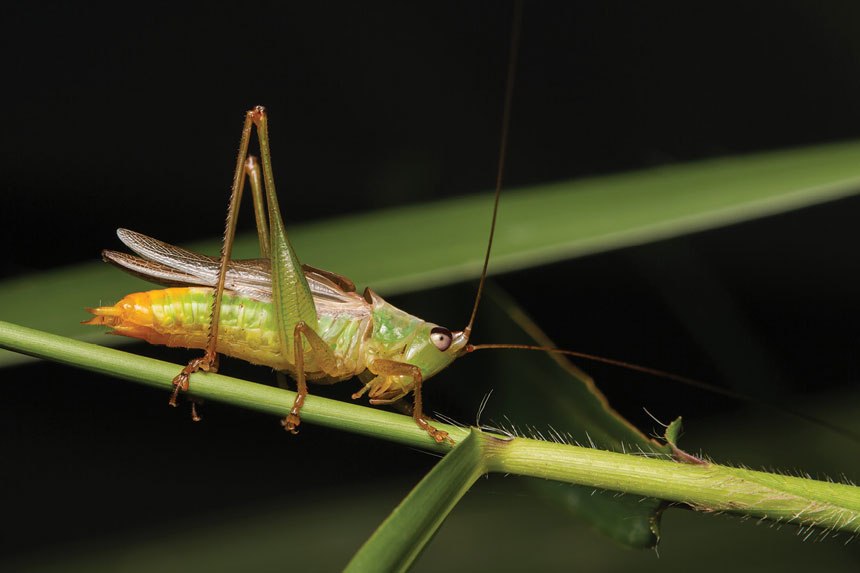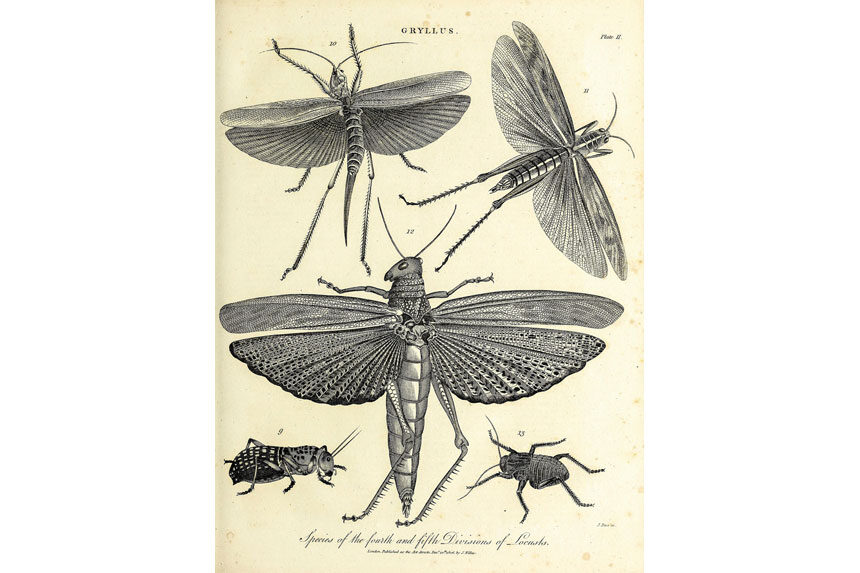Grasshoppers clatter away from me as I walk the verge of a country road. Crickets chirp from hiding places in the unkempt thatch of grass. A fritillary butterfly wings past. Every minute or two, I pass through a thin cloud of midges and I wave my hands to sweep away their mote-like bodies. The cicadas, loud and persistent yesterday afternoon, give only sporadic croaks and stuttering whines in the cool morning.
On one side of the road, exposed rock the color of raw liver angles up the valley slope. Entombed within this stone are the ancestors of the insects that fly and sing around me. One of this fossilized swarm bears the earliest known sound-making structure of any animal, a ridge on the wing of an ancient cricket. This fossil is the oldest direct physical evidence of sonic communication.
There should be a shrine here. A monument to honor the first known earthly voice. But pilgrimages instead lead away from these mountains in southern France to the chapels and cathedrals of the lowlands. The Camino de Santiago passes by; pilgrims tread the road unaware that the deepest known root of all song and speech lies in the stones under their feet.
I am on the southern edge of the Massif Central, a complex of mountains and steep riverine valleys that curves inland along the Mediterranean coast, then stretches north, covering nearly one-sixth of France’s land area. These rocks, the Salagou Formation, named for a local river, are made from sediments laid down in a semiarid basin into which heavy rains sometimes carved lakes and rivulets. Scrubby ferns and conifers grew beside these wet areas, adding patches and corridors of green to an otherwise bare landscape. The formation dates from the Permian, 270 million years ago, a time when all Earth’s land masses were united in one giant continent, Pangaea.
Jean Lapeyrie, a local medical doctor, discovered in the 1990s that the colorful outcrops near his home were, in some places, richly peppered with fossilized insects. He made collections and, through collaborations with researchers across the world, opened a rare window into a time when the earliest members of modern families of insects mingled with now-extinct groups. Mayflies, lacewings, thrips, and dragonflies flew alongside ancient forms, including several relatives of modern crickets and grasshoppers.
Most of the insect fossils are of wings. Insect bodies decompose quickly, but their wings are made of dry, tough protein. Blown or washed into water channels or mud cracks, the wings became entombed in silty ooze. Later, unearthed from their funerary vaults by geologists’ hammers, wing veins and contours are visible as impressions in stone. Every type of insect has its own wing shape and vein arrangement, so a fossilized wing can identify the taxonomic family of its long-dead owner.
In the Permian rocks of the Salagou Formation, one wing bears an unusual feature. Normally wing veins are arranged in a web, supporting a thin membrane. On one fossil specimen, though, a cluster of veins near the attachment point of the wing is thickened and raised. A slightly curved prominent central vein is buttressed by side veins. This convergence of embossed veins is just a couple of millimeters long, the length of a letter on this page, on a wing half the length of my thumb. Such a structure, a raised ridge, had no function in supporting the wing membrane. Instead, it was likely the insect’s singing device. When the wings rubbed together, the raised central vein scraped over the base of the other wing, making a scratchy sound. The large flat surface of the wing may have acted like a loudspeaker, broadcasting the sound.

Modern crickets use a similar wing structure to make sound, although theirs is of a more refined design. It is likely that the sound the animal made was a simple rasp, without the purity of tone achieved by the precisely tuned structures of today’s crickets.
The scientists who described the fossil in 2003 named the species Permostridulus — from Permian, the geologic age of the fossil, and stridulate, the zoological term for rubbing body parts together to make sound. The ridge in Permostridulus is made from the union of a different set of veins than those of modern crickets. The species belongs in its own taxonomic family, a clan now extinct, an early, distant relative of modern crickets.

When it was alive, Permostridulus’s arthropod companions were other insects, spiders, scorpions, and, in the temporary pools, swarms of small crustaceans. Our distant ancestors and their kin were there, too, their lizard-like bodies leaving footprints in the mud, preserved as tracks of fossilized prints. These reptiles, known as therapsids, ranged from iguana- to crocodile-sized and stalked the land on legs held vertically, unlike the sprawling gait of most reptiles and amphibians today. Some of their kind would, over the next 50 million years, shrink, gain a furry pelt, and evolve into what we now call mammals. But in the Permian, therapsids were reptilian-skinned browsers and predators, the dominant large animals in many land environments.
These forebears of the mammals most likely could not hear the insects’ sounds. An ear adapted to higher sounds would come later in the evolution of these animals, when forest and plains were filled with edible singing insects and when the therapsid body transformed into the compact insect-hunting frame of the early mammals.
The arthropods of the time, though, could hear Permostridulus’s song. We don’t know why Permostridulus made its sound. Living crickets sing to attract mates and defend territories. It is possible that the wing’s sound gave the ancient insect an advantage in the breeding season, perhaps by garnering attention, bluffing away rivals, or revealing location to searching mates, just as the chirping of crickets does today. As long as the breeding advantage was larger than the increased risk of predation, the song would have been favored by natural selection.

Perhaps, though, the wing’s sound-making ridge served a defensive purpose. A burst of sound can startle attacking predators, buying time for an escape. This sonic defense would have been especially effective in a world where such calls were rare. Imagine the shock that a pouncing spider experienced on feeling a buzz in its jaws or hearing an unexpected rasp at close quarters. To this day, vibratory startle responses are common. Pluck an arthropod from its home and you’ll often get a short blast of sound. Animals as diverse as lobsters, spiders, millipedes, crickets, beetles, and pillbugs all give defensive vibrations. Experiments with predatory wasps, spiders, and mice show that these vibratory alarms do indeed offer protection, startling attackers enough to allow potential prey to escape.
Whatever its function, the wing ridge in Permostridulus presaged further developments in an insect group whose relatives would become some of the world’s singing champions. Some, the crickets and katydids, make sound by rubbing files and plectra on their wings. Others, grasshoppers and giant flightless crickets called wetas, rasp hind legs onto ridges on their abdomens. Sound-making wings and legs are supplemented in some species by rasping mouthparts, wheezing air tubes, drumming abdomens, and wings shaped to crackle and snap as they fly.
Permostridulus is, for now, the earliest known singer in the fossil record. But it was surely not the first animal to make a communicative sound. The fossil record is incomplete and gives us only very conservative estimates of the antiquity of evolutionary innovations, especially innovations like tiny ridges on insect wings that do not preserve well in stone.
After the long silence of Earth’s first 3.5 billion years, insects gave the terrestrial world its first songs. Ancient forests of fern, cycad, club moss, and conifer were brightened with sounds that would be familiar to our ears. When we hear crickets chirping from the mulch in a city park, in a mountain meadow, or along a rural road, we are transported to the first days of song on Earth.
David Haskell, Ph.D., is a professor of biology and environmental studies at the University of the South and a Guggenheim Fellow whose work has appeared in The New York Times, Scientific American, and other media. He is the author of The Song of the Trees and The Forest Unseen. For more, visit dghaskell.com.
From Sounds Wild and Broken by David George Haskell, Published by Viking, an imprint of The Penguin Publishing Group, A division of Penguin Random House, LLC. Copyright © 2022 by David George Haskell
This article is featured in the May/June 2023 issue of The Saturday Evening Post. Subscribe to the magazine for more art, inspiring stories, fiction, humor, and features from our archives.
Become a Saturday Evening Post member and enjoy unlimited access. Subscribe now



